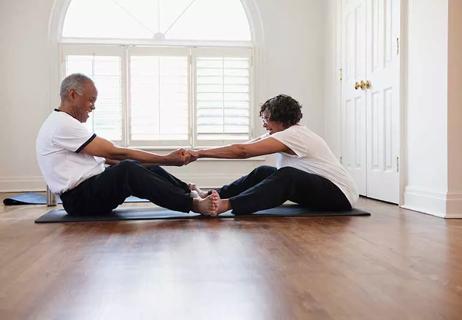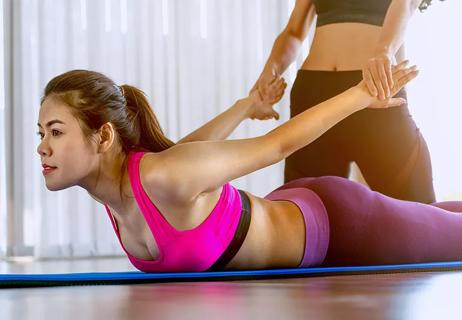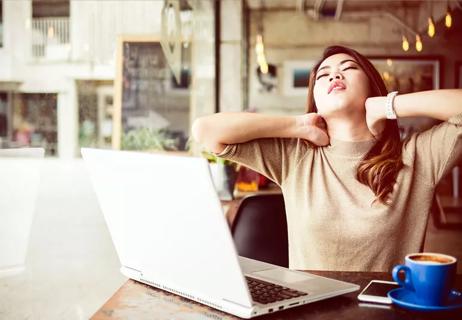Counteract psoas muscle stiffness and soreness with stretches that lengthen and strengthen

Running from each of your upper inner thighs, over your pelvis bone and to the sides of your spine are two long ribbons of muscle that make a big difference in how you stand, sit, walk and more.
Advertisement
Cleveland Clinic is a non-profit academic medical center. Advertising on our site helps support our mission. We do not endorse non-Cleveland Clinic products or services. Policy
They’re your psoas muscles (that’s pronounced “SO-ezz”), and they have two primary uses. For starters, your psoas muscles work as hip flexors. That allows you to do things like move your knees up toward your body, like when you march or walk up stairs. They also help keep your spine stable when you’re standing, walking, bending and more.
And when they’re weak or aggravated, your psoas muscles can be a real pain. Literally. Particularly in your lower back or the front of your hips.
Of course, lots of things can cause back pain, so it’s important to know where your pain is coming from in order to manage it properly. But if your healthcare provider has suggested your psoas muscles are the culprit, there are several psoas stretches and exercises that can help relieve aches and stiffness.
“Your psoas can be aggravated from under-use as well as over-use,” says board-certified physical therapist and certified strength and conditioning specialist Dawn Lorring, PT. “If you’re sitting for a long period of time, your psoas muscles can get angry when you try to stand. Likewise, if you do something your body isn’t used to, like take a long walk on a hilly road, it can irritate your psoas muscles because you’re asking them to do much more than you usually do.”
Advertisement
Lorring walks us through some of the psoas stretches and exercises to lengthen and strengthen these important muscles.
Tightness and pain in your psoas typically stem from muscles that are weak or that need to be stretched out. Or a combination of both.
“If we spend long times in one position, like sitting at your desk, your psoas muscles get stiff because they’ve been shortened for long periods,” Lorring explains. “When you don’t use it, you lose it. So weakness sets in.”
Lorring shares these psoas stretches ways to help give your muscles the attention they need. (Bonus: Most of them don’t even need any exercise equipment!)
Why does it help?
“The dangling leg gets the benefit of being in a really comfortable position for the psoas muscle and it helps to let it relax and lengthen,” Lorring points out. “It’s a good stretch to try to counteract long periods of sitting and shortening your psoas.”
“The trick with that one is that it requires some focus on your form,” Lorring clarifies. “If you arch your back, you won’t get the stretch in your psoas that you’re looking for. You want to pull your buttock muscles tight so that you don’t let your back arch.”
That may mean not lunging as far forward as you think you “should.” And that’s OK.
“More is not better. Proper form is better. That’s what’s going to help your muscles the most,” she emphasizes.
Add strength to your psoas muscles by giving them some work. Remember that your psoas muscles help to lift your knees. So bringing your knees up toward your chest is an effective way to get them going.
Advertisement
You can try:
If you have access to a yoga ball (also called a stability ball), it can be used to help lengthen your psoas muscles.
“This is a good exercise because it’s making your buttock muscles work, which allows the psoas muscles at the front of your hips to relax and strengthen,” Lorring says.
In addition to psoas muscle stretches, making a few changes to your daily routine can make a big difference.
If you’re spending long hours working at your desk, set a timer to encourage you to stand up and walk around every hour or so. Same goes if you’re in the car for long hours. Take a rest from driving and give your psoas some work with some marching and stretching.
Advertisement
But if psoas stretches and some extra movement aren’t cutting it, talking with a healthcare provider can help.
“It’s not always obvious what’s causing muscle pain and why,” Lorring shares. “Getting evaluated by a physical therapist can help you get to the root of the problem: Is it tightness? Weakness? A combination of both?”
Seeking care can help to ensure you’re addressing the right problem — and managing it with the right solutions.
Remember, though, whatever you do, take it slow and steady. Too much too fast can exaggerate the problem.
“Angry muscles won’t tolerate stretches,” Lorring says. “Start gentle and work your way up.”
Advertisement
Learn more about our editorial process.
Advertisement

Shoulder rolls, hamstring stretches and calf exercises can all improve flexibility and endurance

This satisfying, involuntary act of yawning and stretching helps release tight muscles

While one focuses on stretching through movement, the other requires holding poses for 30 to 90 seconds — both can have a place in your fitness routine

Stretch before and after your workouts for maximum benefits, but your pre-workout stretches should be different from your post-workout stretches

Having a partner help you stretch can prevent injury and lead to an increased range of motion

Simply contracting certain muscles provides a good stretch to other areas of your body

Relax into this form of stretching while a prop or partner assists you

Reduce pain and stiffness by stretching your body throughout the day

Start having sex about 72 hours before ovulation, then at least every other day during your fertile window

Attachment theory suggests that your earliest relationships shape connections throughout your life

It isn’t a recognized mental health disorder, but research shows that problematic social media use can negatively affect your mental health, self-esteem and sleep